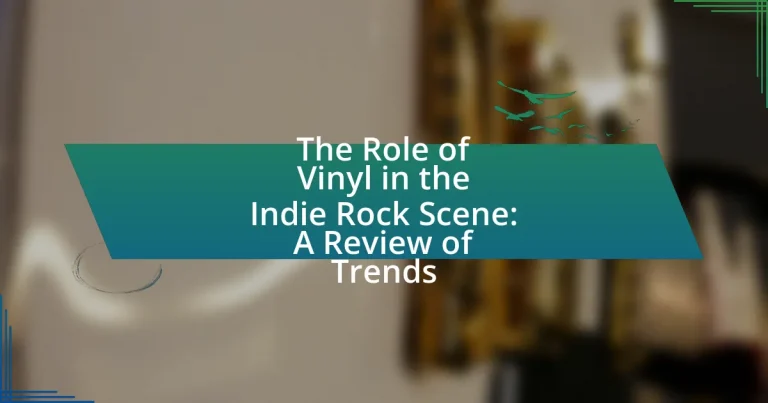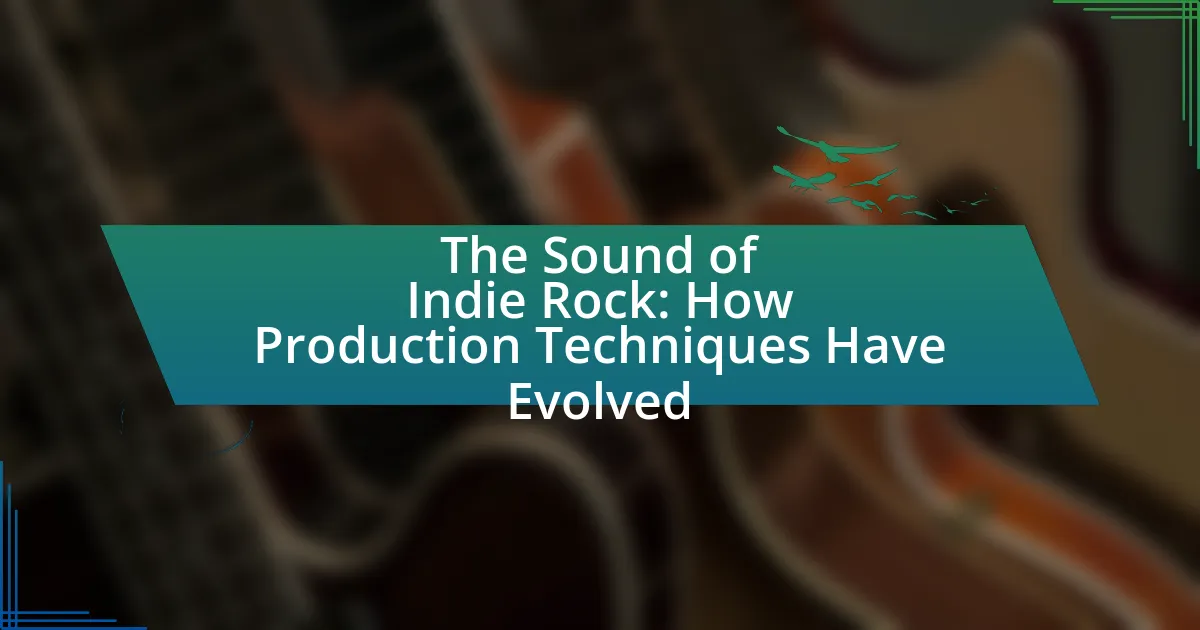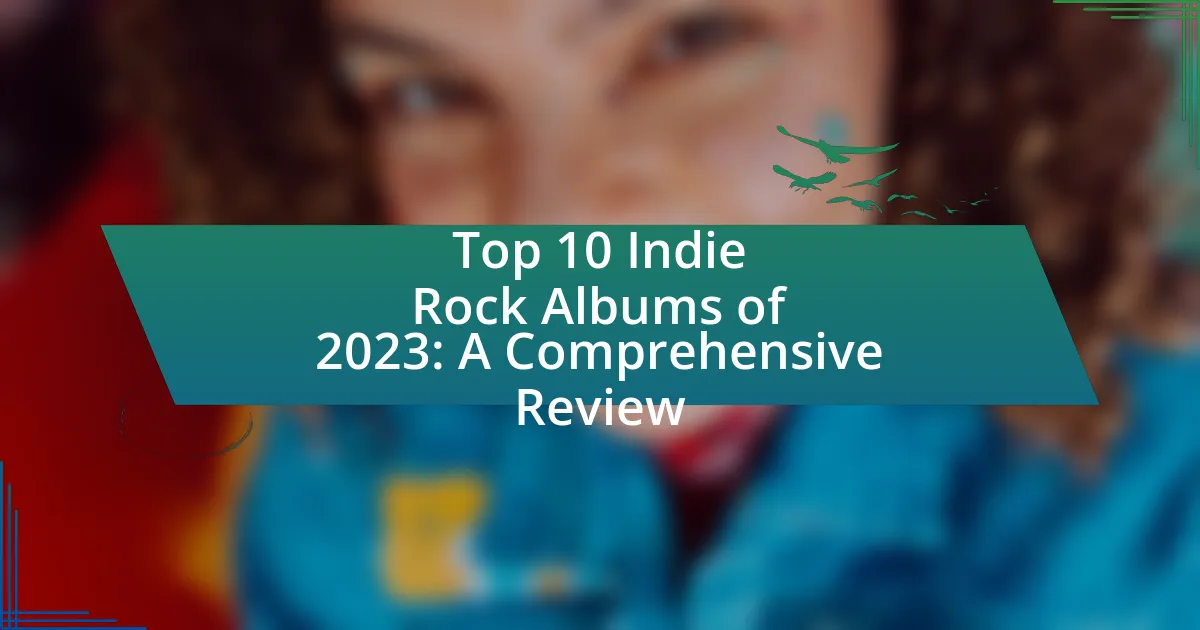The article examines the significant role of vinyl in the indie rock scene, highlighting its resurgence as a preferred medium for music distribution and its impact on artist-fan connections. It discusses how vinyl enhances the aesthetic experience of music consumption through unique artwork and packaging, while also supporting the independent music economy. Key trends include the increasing sales of vinyl records, the strategies indie artists and labels employ to promote vinyl releases, and the emotional connections fans have with this format. Additionally, the article addresses the challenges and opportunities faced by indie artists in the current vinyl market, including production costs and environmental concerns.
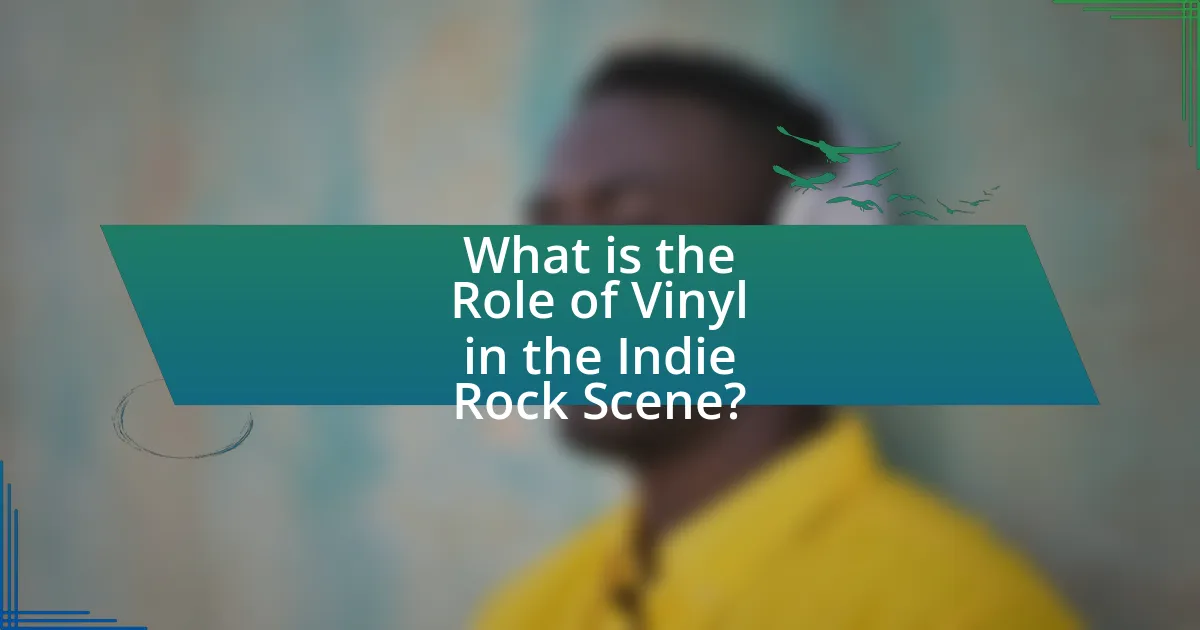
What is the Role of Vinyl in the Indie Rock Scene?
Vinyl plays a crucial role in the indie rock scene by serving as a tangible medium for music distribution and fostering a sense of authenticity among artists and fans. The resurgence of vinyl sales, which reached 41 million units in the U.S. in 2020, highlights its importance as a preferred format for indie bands seeking to create a physical connection with their audience. Additionally, vinyl records often feature unique artwork and packaging, enhancing the overall artistic experience and allowing indie artists to express their identity. This format not only supports the independent music economy but also cultivates a dedicated community of collectors and enthusiasts who value the tactile and auditory qualities of vinyl.
How has vinyl influenced the indie rock genre?
Vinyl has significantly influenced the indie rock genre by providing a tangible medium that enhances the aesthetic and cultural experience of music consumption. The resurgence of vinyl records since the early 2000s has allowed indie rock artists to connect with audiences through limited edition releases, unique artwork, and the nostalgic appeal of analog sound. According to the Recording Industry Association of America (RIAA), vinyl sales reached a 30-year high in 2020, indicating a strong consumer preference for this format, particularly among younger listeners who are drawn to the authenticity and collectibility associated with vinyl records. This trend has encouraged indie bands to prioritize vinyl releases, fostering a sense of community and supporting independent record stores, which are often vital to the indie music ecosystem.
What historical factors contributed to the resurgence of vinyl in indie rock?
The resurgence of vinyl in indie rock can be attributed to a combination of nostalgia, the desire for tangible music formats, and the rise of independent record labels. Nostalgia for the analog sound and aesthetic of vinyl records has driven both artists and fans to embrace this medium, as seen in the growing number of vinyl releases by indie bands since the early 2000s. The tangible nature of vinyl, which contrasts with the digital music experience, appeals to consumers seeking a more immersive and authentic connection to music. Additionally, independent record labels have played a crucial role by prioritizing vinyl releases, often using limited editions and unique artwork to attract collectors. According to the Recording Industry Association of America, vinyl sales reached a 30-year high in 2020, indicating a significant trend that aligns with the indie rock scene’s embrace of this format.
How do indie rock artists utilize vinyl in their music distribution?
Indie rock artists utilize vinyl in their music distribution primarily to create a tangible product that enhances the listening experience and fosters a deeper connection with fans. By releasing music on vinyl, these artists tap into the growing demand for physical formats, which has seen a resurgence; for instance, vinyl sales in the U.S. reached 41 million units in 2020, the highest since 1986, according to the Recording Industry Association of America. This format allows indie artists to offer unique packaging, limited editions, and exclusive content, which can attract collectors and dedicated fans. Additionally, vinyl releases often serve as a marketing tool, helping to promote tours and merchandise, thereby increasing overall revenue and visibility in a competitive music landscape.
Why is vinyl significant to indie rock fans?
Vinyl is significant to indie rock fans because it embodies a tangible connection to the music and culture they cherish. This format allows for a richer sound quality, which many enthusiasts believe enhances the listening experience compared to digital formats. Additionally, vinyl records often feature unique artwork and packaging, making them collectible items that reflect the artistic vision of indie bands. The resurgence of vinyl sales, which reached 41 million units in the U.S. in 2022, underscores its importance in the indie rock community, as fans seek to support artists and enjoy music in a more immersive way.
What emotional connections do fans have with vinyl records?
Fans have deep emotional connections with vinyl records due to their tangible nature and the nostalgia they evoke. The physicality of vinyl, including the large album artwork and the ritual of placing a record on a turntable, creates a sensory experience that digital formats cannot replicate. This connection is often rooted in personal memories, such as listening to records with family or friends, which enhances the emotional significance of the music. Additionally, studies indicate that the analog sound quality of vinyl is perceived as warmer and more authentic, further deepening the emotional engagement fans have with their favorite albums.
How does the tactile experience of vinyl enhance music enjoyment?
The tactile experience of vinyl enhances music enjoyment by engaging listeners physically and emotionally, creating a deeper connection to the music. Handling vinyl records involves a deliberate process of selecting, placing, and playing the record, which fosters a sense of ritual and anticipation that digital formats lack. This physical interaction not only heightens the sensory experience but also encourages active listening, as listeners are more likely to focus on the music when they are engaged in the process. Studies have shown that the act of physically manipulating a record can evoke nostalgia and emotional responses, further enriching the listening experience.

What Trends are Emerging in Vinyl Usage within Indie Rock?
Emerging trends in vinyl usage within indie rock include a significant resurgence in sales, with vinyl records accounting for over 50% of physical music sales in the U.S. as of 2022. This trend is driven by indie artists increasingly releasing limited edition vinyl to enhance collector appeal and create a tangible connection with fans. Additionally, the rise of direct-to-consumer sales through artist websites and social media platforms has facilitated this growth, allowing indie bands to reach niche audiences effectively. The popularity of vinyl is further supported by the growing interest in analog sound quality and the aesthetic value of vinyl packaging, which resonates with the indie rock ethos of authenticity and artistic expression.
How are indie labels adapting to the vinyl trend?
Indie labels are adapting to the vinyl trend by increasing their production of vinyl records and offering unique, limited-edition releases. This shift is driven by the resurgence of vinyl sales, which reached 41 million units in the U.S. in 2022, marking a 17% increase from the previous year, according to the Recording Industry Association of America. Additionally, indie labels are leveraging the collectible nature of vinyl by collaborating with artists to create exclusive artwork and colored vinyl variants, appealing to both collectors and fans. This strategy not only enhances their market presence but also aligns with consumer demand for tangible music formats.
What strategies are indie labels using to promote vinyl releases?
Indie labels are utilizing a variety of strategies to promote vinyl releases, including limited edition pressings, social media marketing, and collaborations with local artists. Limited edition pressings create a sense of exclusivity and urgency, often leading to higher demand; for instance, many labels release colored vinyl or special packaging to attract collectors. Social media marketing leverages platforms like Instagram and TikTok to engage with fans, showcasing the aesthetic appeal of vinyl and sharing behind-the-scenes content. Collaborations with local artists not only enhance community ties but also expand reach through cross-promotion, as seen in events where multiple artists perform and promote their vinyl together. These strategies collectively enhance visibility and sales for indie labels in the competitive music market.
How has the production process for vinyl changed in recent years?
The production process for vinyl has significantly evolved in recent years due to advancements in technology and increased demand. Modern vinyl manufacturing now utilizes digital cutting techniques, which enhance precision and reduce production time compared to traditional analog methods. Additionally, the resurgence of vinyl popularity has led to the establishment of more pressing plants, allowing for shorter turnaround times and greater accessibility for independent artists. According to the Recording Industry Association of America, vinyl sales reached a 30-year high in 2020, indicating a robust market that has prompted these changes in production practices.
What role does vinyl play in live performances and merchandise?
Vinyl serves as a significant medium for both live performances and merchandise in the indie rock scene. During live performances, artists often sell vinyl records at shows, creating a tangible connection between the audience and the music, which enhances the overall experience. This practice not only provides fans with a physical product to take home but also supports the artist financially, as vinyl sales can contribute substantially to their income.
Moreover, vinyl records are often seen as collectible items, appealing to fans who value the aesthetic and tactile qualities of the format. According to the Recording Industry Association of America (RIAA), vinyl sales have seen a resurgence, with revenue from vinyl records surpassing that of CD sales in recent years, indicating a strong market demand. This trend underscores the importance of vinyl in merchandise strategies for indie rock artists, as it allows them to capitalize on the growing interest in physical music formats.
How do artists incorporate vinyl into their concert experiences?
Artists incorporate vinyl into their concert experiences by using it as a medium for live performances and merchandise sales. Many musicians play tracks directly from vinyl records during their shows, creating a unique auditory experience that emphasizes the warmth and authenticity of analog sound. Additionally, artists often sell exclusive vinyl editions of their albums at concerts, enhancing the connection with fans and providing a tangible product that complements the live experience. This practice not only caters to the growing vinyl revival but also reinforces the cultural significance of vinyl in the indie rock scene, where physical formats are valued for their artistic and collectible nature.
What are the sales trends for vinyl at indie shows and festivals?
Sales trends for vinyl at indie shows and festivals indicate a significant increase in demand, particularly among younger audiences. Data from the Recording Industry Association of America (RIAA) shows that vinyl sales have grown consistently over the past decade, with a notable spike during live events, where unique pressings and limited editions often attract collectors. For instance, a 2022 survey revealed that 70% of attendees at indie festivals purchased vinyl records, highlighting the format’s resurgence as a preferred medium for music consumption in this niche market.
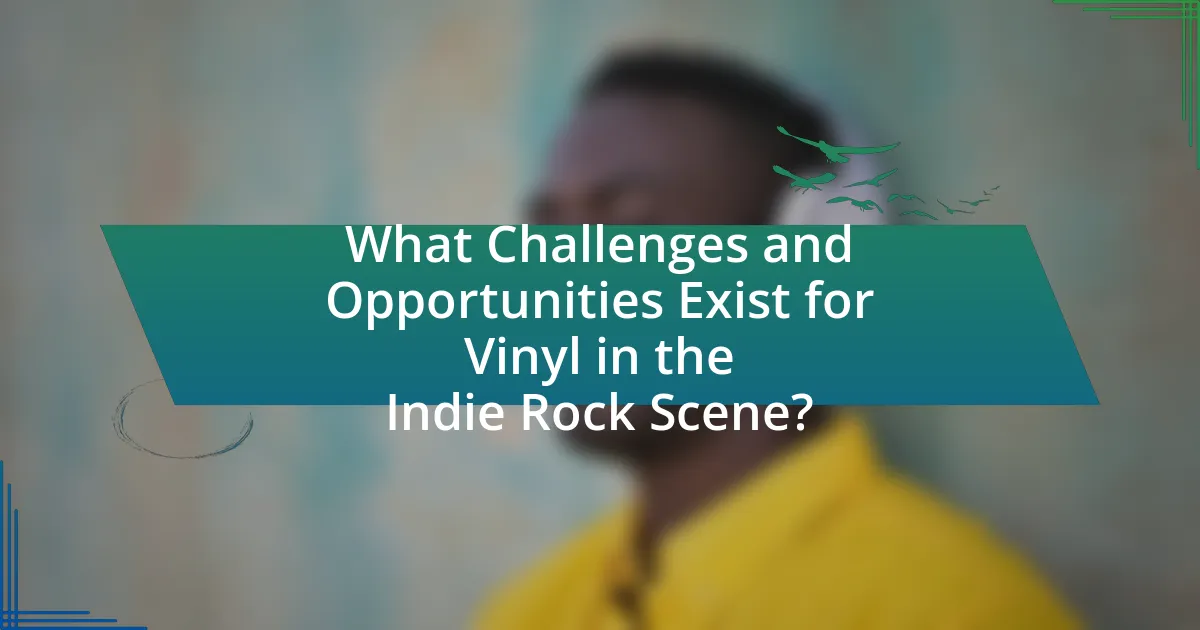
What Challenges and Opportunities Exist for Vinyl in the Indie Rock Scene?
Vinyl faces challenges and opportunities in the indie rock scene primarily due to production costs and consumer demand. The resurgence of vinyl has created a niche market, with sales reaching 41 million units in the U.S. in 2022, indicating strong consumer interest. However, the high manufacturing costs and longer production times can strain indie labels and artists, limiting their ability to release new music on vinyl. Additionally, the environmental impact of vinyl production poses a challenge, as sustainability becomes increasingly important to consumers. Despite these challenges, the unique sound quality and tangible nature of vinyl provide indie artists with an opportunity to enhance their brand and connect with fans on a deeper level, fostering loyalty and community engagement.
What are the main challenges facing vinyl production today?
The main challenges facing vinyl production today include supply chain disruptions, increased demand outpacing production capacity, and rising material costs. Supply chain issues, exacerbated by the COVID-19 pandemic, have led to delays in obtaining raw materials such as PVC, which is essential for vinyl records. Additionally, the resurgence of vinyl popularity has resulted in a significant increase in demand, with sales reaching 41 million units in the U.S. in 2022, yet many pressing plants struggle to keep up with this surge. Furthermore, the cost of materials has risen sharply, impacting the overall production costs and making it difficult for smaller labels to maintain profitability.
How do supply chain issues affect vinyl availability for indie artists?
Supply chain issues significantly limit vinyl availability for indie artists by causing delays in production and distribution. These disruptions can arise from shortages of raw materials, such as PVC, which is essential for vinyl manufacturing, and logistical challenges like transportation delays. For instance, during the COVID-19 pandemic, many pressing plants faced closures or reduced capacity, leading to longer wait times for indie artists to get their records produced. As a result, indie artists may struggle to meet demand for their music, impacting their sales and visibility in a competitive market.
What environmental concerns are associated with vinyl production?
Vinyl production is associated with several environmental concerns, primarily due to the use of polyvinyl chloride (PVC) and the manufacturing processes involved. The production of PVC releases harmful chemicals, including dioxins, which can contaminate air and water sources. Additionally, the energy-intensive manufacturing process contributes to greenhouse gas emissions. According to a study by the European Commission, the lifecycle of vinyl products, including their production and disposal, poses significant environmental risks, highlighting the need for sustainable alternatives.
What opportunities can indie artists leverage from the vinyl trend?
Indie artists can leverage the vinyl trend by tapping into the growing consumer demand for physical music formats, which has seen a resurgence in popularity. In 2022, vinyl sales in the U.S. surpassed CD sales for the first time since the 1980s, indicating a significant market opportunity. This trend allows indie artists to create limited edition vinyl releases, enhancing their brand’s exclusivity and appeal. Additionally, vinyl records often command higher price points than digital downloads, providing artists with increased revenue per sale. The tactile nature of vinyl also fosters a deeper connection with fans, as collectors value the physical product and the artwork associated with it. By participating in Record Store Day and collaborating with independent record shops, indie artists can further promote their vinyl releases, reaching dedicated music enthusiasts.
How can artists use vinyl to enhance their brand identity?
Artists can use vinyl to enhance their brand identity by creating a tangible product that reflects their unique style and aesthetic. Vinyl records offer a physical medium that allows artists to showcase their artwork, lyrics, and overall branding in a way that digital formats cannot. The resurgence of vinyl sales, which reached 41 million units in the U.S. in 2020, demonstrates consumer demand for this format, allowing artists to connect with fans on a deeper level through collectible items. Additionally, limited edition releases and unique packaging can create exclusivity, further solidifying an artist’s brand identity in the competitive indie rock scene.
What innovative marketing strategies are being employed for vinyl releases?
Innovative marketing strategies for vinyl releases include limited edition pressings, exclusive artwork, and bundled merchandise. These strategies create a sense of scarcity and exclusivity, appealing to collectors and fans. For instance, artists often release colored vinyl or special packaging that enhances the aesthetic value, driving demand. Additionally, leveraging social media platforms for direct engagement and pre-order campaigns has proven effective; a 2022 report by the Recording Industry Association of America noted a 50% increase in vinyl sales attributed to targeted online promotions. Collaborations with local record stores for in-store events further enhance community engagement and visibility, solidifying the vinyl’s cultural relevance in the indie rock scene.
What are the best practices for indie artists releasing vinyl records?
Indie artists releasing vinyl records should prioritize high-quality production, effective marketing strategies, and strategic distribution channels. High-quality production involves selecting reputable pressing plants and ensuring optimal sound quality, as vinyl’s appeal is closely tied to its audio fidelity. Effective marketing strategies include leveraging social media platforms, engaging with fans through pre-order campaigns, and utilizing email newsletters to build anticipation. Strategic distribution channels involve partnering with independent record stores and online platforms that cater to vinyl enthusiasts, as this can enhance visibility and sales. According to a report by the Recording Industry Association of America, vinyl sales have seen a resurgence, with revenue reaching over $1 billion in 2022, highlighting the importance of these practices for indie artists aiming to capitalize on this trend.
